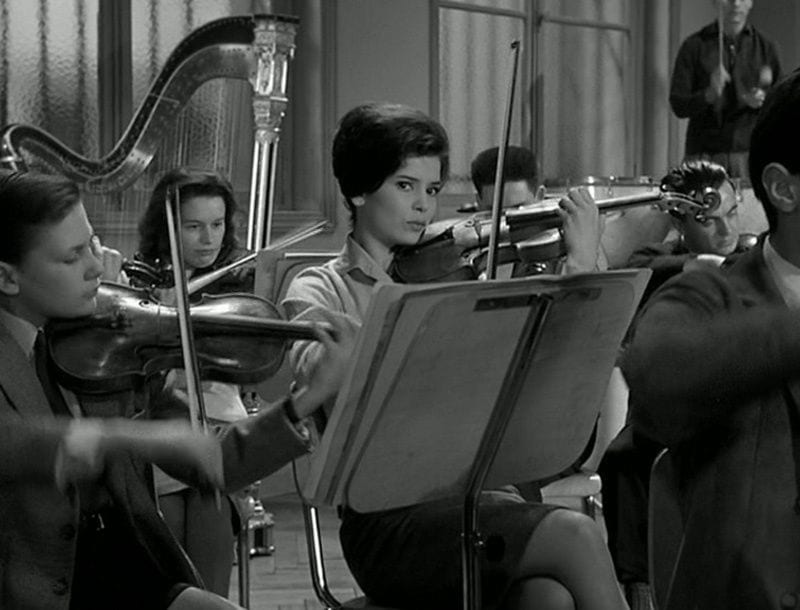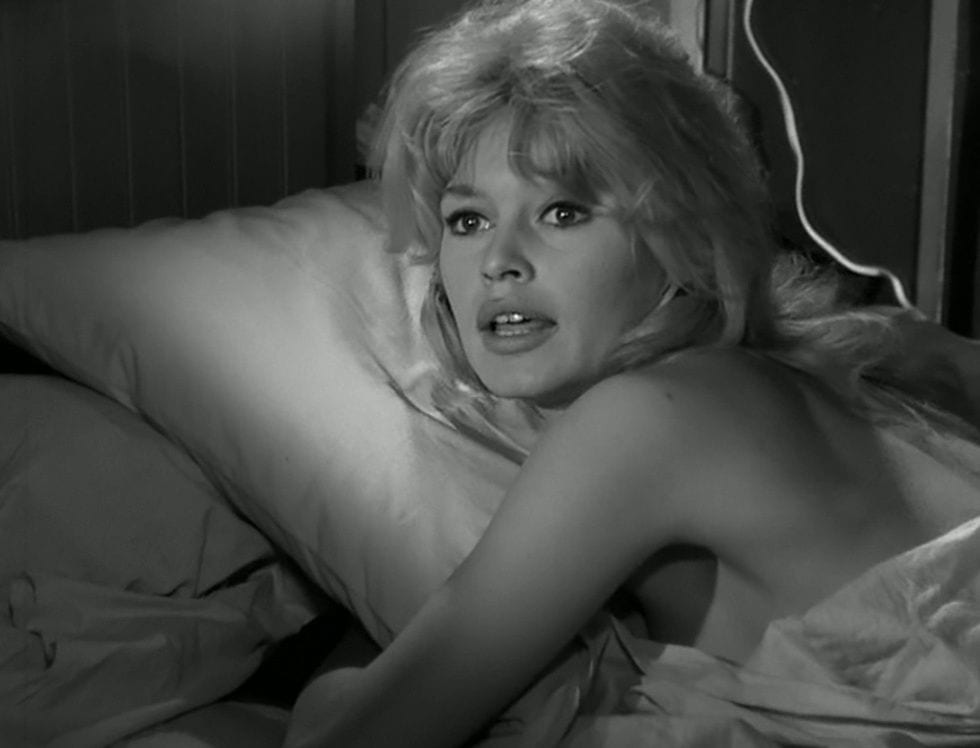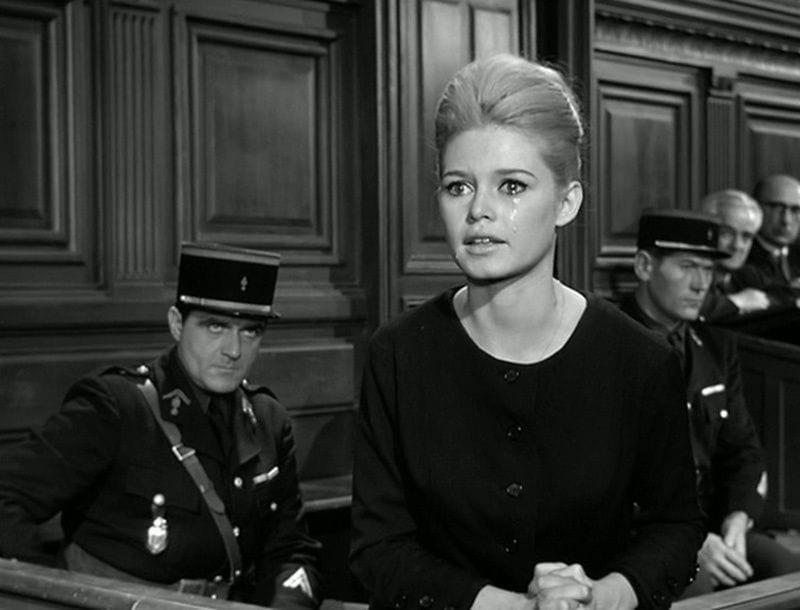
I’m often bemused by the observation that French movies are “mature” and “adult”, since the two themes that recur most often in French art films are bittersweet autobiographical childhoods and that particularly melodramatic species of mentally arrested adolescence known as “l’amour fou“, which French cinema virtually celebrates as a pillar of culture. The latter theme I’ve found especially tiresome, as it makes you empathize with the French penchant for wanting to slap everybody. Still, on the theory that a few examples will be outstanding if you make enough of them, Henri-Georges Clouzot pulled off something close to a masterpiece with La Vérité (1960), or “The Truth“, now available at long last in Region 1, thanks to Criterion.
As Clouzot explains in a bonus archival interview on this Blu-ray, he’d wanted to make a movie about the legal system in order to show that it’s not possible to judge people’s actions or to summarize their character effectively in such a forum. He’d written a script for Sophia Loren when he was approached by Brigitte Bardot’s producer, Raoul Lévy, who asked him to use Bardot instead. Clouzot states that he wrote an entirely new script tailored to her personality and reputation, in which she plays a woman accused of killing her lover, a woman in the process of being torn apart and sensationalized in the tabloids as a murderous hoyden.
In other words, what makes this example of “l’amour fou” work as cinema is that it’s really about the public image of Bardot the icon. At every point, the analysis of the heroine can be confused with an analysis of the star playing her, and Bardot’s naked performance (sometimes literally) encourages such confusion.
The film is structured as a courtroom drama where the testimony includes a series of flashbacks that recount the fatal romance in chronological order. This isn’t a film that questions the implicit truth of the flashbacks. The film indulges no trickery about unreliable narrators or any such post-modernisms, nor does it truck with the self-conscious modernisms of the French New Wave. Despite Clouzot’s apparent belief that a trial can’t summarize a person’s life, he has faith in cinema’s ability to do the same in two hours, and his agenda is to make us understand the truth behind the way things are slanted by the prosecution, the defense, and the witnesses.
While the charges are being read to a packed house — for the trial and its “casting” of jurors amid costumed players before an audience and a bench of scribbling “critics” is explicitly presented as a kind of dramatic theatre — the first flashback presents the shocking discovery of the crime. A young man lies dead in his locked apartment while, in the kitchen filling with gas vapors, our heroine lies with her eyes open. When revived from near death by medics, she will admit to shooting her lover and claim it was a crazed impulse on her way to suicide. In her liner notes, Ginette Vincendeau notes the parallels with the 1953 case of Pauline Dubuisson, which had gripped France.
No matter who’s testifying at the moment, all flashbacks essentially reveal the point of view of Dominique Marceau (Bardot), a provincial hick who flees to Paris with her younger sister Annie (Marie-José Nat), a violin student who falls in love with aspiring conductor Gilbert (Sami Frey). The latter becomes obsessed with Dominique when he comes upon her, obviously nude under her bedsheets, shaking her rump to a piece of faux-Latin pop drivel — specifically, the song “Yo Tengo una Muneca” (“I have a doll”), a title we may read as significant. Gilbert’s bag is Bach and Stravinsky, and the film uses the latter’s The Firebird to fine effect.
I don’t know whether we’re meant to associate Dominique with that mythical creature of Stravinsky’s ballet, but Bardot was certainly already a mythical creature since her breakthrough in Roger Vadim’s And God Created Woman (1956). She was the most sensational figure in France, perhaps in all Europe, and the object of what we now call a media frenzy that glamorized and lionized her while simultaneously condemning and inflaming criticism of her as a symbol or reality of modern sexual liberation.
Simone de Beauvoir had celebrated her as such, and this film ironically repays the compliment by having Dominique recall that, as a schoolgirl, she found Beauvoir’s novel, The Mandarins, boring. Her advocate asks if de Beauvoir is on trial here. Rhetorically, he means “no” while the film means “yes”.
The spirit of Beauvoir not only prevails but the eye of the once-scandalous Stravinsky, whose picture is shown in an early scene. When Dominique first spends the night with a platonic friend (with benefits), he makes a completely gratuitous political remark about “fireworks”, which in French is “eaux d’artifice” — another Stravinsky piece. This association is surely the only reason for the dialogue. The film seems to be observing that a composer who had once contributed to the most famous artistic riot in Paris — the 1913 premiere of Rite of Spring — now belongs to the conservative tradition of musical longhairs, literally the Paris Conservatoire. And so it goes.
Let’s get back to the plot. After false starts, Gilbert’s persistence leads to their affair, but he and Dominique are irreconcilable in taste and temperament. She’s a free spirit and non-intellectual, even an airhead, who wants to party with friends and sleep ’til noon and generally be the opposite of uptight and responsible, while he flies into possessive rages on the hour. On the positive side, the sex is so good that it can only be expressed with a composition of extravagant expressionism that nevertheless divides them into opposite corners of the screen by an impenetrable chasm of darkness. This image becomes a premonition of the death we’ve already seen.
Dueling in court, as it were, over Dominique’s possibly soon-to-be-dead body, are two stars of Clouzot’s most celebrated films. From The Wages of Fear (1953) comes Charles Vanel as the cynical defense attorney, who believes the only hope lies in the specifically French plea of “crime of passion”, which means a much lighter punishment for killing your lover. He wishes she wouldn’t speak for herself and, like Pilate, is constantly asking what is truth. He makes sure women are barred from the jury.
From Les Diaboliques (1955) comes Paul Meurisse as the equally cynical and manipulative prosecutor who’s been hired by the victim’s mother. His job is to paint Dominique as an immoral slut and provoke confessions and observations of the type that cause the bourgeois matrons and fuddy-duddies who seem to comprise the entire audience to cluck and murmur at the decline in morals today as they follow every remark avidly. In its sleeker way, this movie offers as much a criticism of conservative France as Clouzot’s infamous wartime drama, Le Corbeau (1943), which caused everyone to condemn him. He thought nothing of biting the hand that bought the tickets, and this dissection of justice can be seen as a response to his own wartime accusers, an attempt to undermine the complacency of judgments.
It might also be seen as another of his essays in the uncontrollable nature of women whom men seek to control. This situation leads to violence throughout his work, not only in his mystery and suspense films but in Manon, his 1949 update of Abbé Prévost’s novel about an incorrigible hussy, except that Clouzot makes it a story of a woman accused of Nazi collaboration. That’s another highly personal work and, sadly, another of the handful of Clouzot films that have never been available on disc (or tape!) in Region 1.
La Vérité marks the start of Clouzot’s final period as a filmmaker, which produced variants of “l’amour fou” in the unfinished Inferno (see the 2010 documentary, Henri-Georges Clouzot’s Inferno) and La prisonnière (1968). It also marked the start of Bardot being taken seriously as an actress, and no wonder. According to her archival interviews in the extras, and the recollection of others in the same material, Clouzot understood that her talent was different from professional actors who gain from rehearsal. He allowed her to carry most of her role without rehearsal and without multiple takes. When the film finally builds to the flashback we’ve been waiting for — the moment of murder — Bardot’s trembling rage, sorrow and despair are matchless as she merges with Dominique.
One telling anecdote from a woman who worked with Bardot states that Clouzot was used to slapping his actors, male and female, apparently to provoke them into attitudes he desired. Another woman who worked with Clouzot confirms that he worked in a kind of sadomasochistic dance with his actors. One of the slappees, actor Bernard Blier, shrugs and says he didn’t take it seriously, while Bardot remembers Clouzot as a “diabolique” who extracted great performances. According to Bardot’s associate, Bardot received one slap, whereupon she returned it and stomped on his foot before chasing him out of her dressing room; he got the point. (Vincendeau’s notes repeat an alternate version in which Clouzot steps on Bardot’s foot, but no source is cited while Bardot’s friend was supposedly with her, so I’ll believe her account.)
One of the actresses Clouzot worked with, of course, was his wife Vera Clouzot, who doesn’t appear here but is credited among the writers along with three other women, Michèle Perrein, Simone Drieu and Christiane Rochefort, as well as Jérôme Géronimi, who worked on Clouzot’s previous three films. Rochefort is a prominent feminist novelist whose The Warrior’s Rest (1958) would be adapted by Vadim into a Bardot vehicle in 1962.
If only the slapping had been the most fraught element of the filming. A series of scandals involving “BB” and health issues involving the Clouzots provided fodder for headlines. Apparently Bardot’s affair with Frey caused a rupture in her marriage to actor Jacques Charrier that culminated in her own suicide attempt shortly before the film’s premiere, thus creating an accidental charge of publicity. Since this is an element in the plot, it was an unfortunate case of life echoing art.
Criterion’s 4K restoration provides a fabulous image shot in smooth, cold black and white by Armand Thirard, who not only shot six previous Clouzot films but three previous Bardot hits, including And God Created Woman. Combining the two strands of French cinema came naturally to him. Another commonality with several Clouzot films is the director’s decision to eschew background score aside from the diegetic music, which doesn’t stop him from cutting one climactic sequence to Stravinsky.
We hope the arrival of this film on Criterion presages the unearthing of further elusive Clouzots, and perhaps some viewers will be encouraged to seek out Bardot’s equally magnificent performance in Jean-Luc Godard’s Contempt (1963). It certainly can’t hurt.





